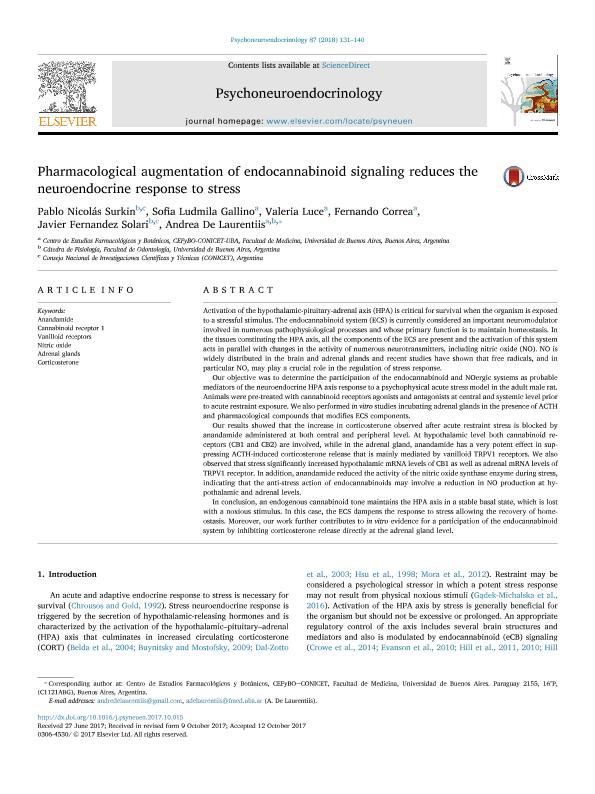Mostrar el registro sencillo del ítem
dc.contributor.author
Surkin, Pablo Nicolas

dc.contributor.author
Gallino, Sofia Ludmila

dc.contributor.author
Luce, Valeria
dc.contributor.author
Correa, Fernando Gabriel

dc.contributor.author
Fernández Solari, José Javier

dc.contributor.author
de Laurentiis, Andrea

dc.date.available
2019-12-27T15:49:44Z
dc.date.issued
2018-01
dc.identifier.citation
Surkin, Pablo Nicolas; Gallino, Sofia Ludmila; Luce, Valeria; Correa, Fernando Gabriel; Fernández Solari, José Javier; et al.; Pharmacological augmentation of endocannabinoid signaling reduces the neuroendocrine response to stress; Pergamon-Elsevier Science Ltd; Psychoneuroendocrinology; 87; 1-2018; 131-140
dc.identifier.issn
0306-4530
dc.identifier.uri
http://hdl.handle.net/11336/93092
dc.description.abstract
Activation of the hypothalamic-pituitary-adrenal axis (HPA) is critical for survival when the organism is exposed to a stressful stimulus. The endocannabinoid system (ECS) is currently considered an important neuromodulator involved in numerous pathophysiological processes and whose primary function is to maintain homeostasis. In the tissues constituting the HPA axis, all the components of the ECS are present and the activation of this system acts in parallel with changes in the activity of numerous neurotransmitters, including nitric oxide (NO). NO is widely distributed in the brain and adrenal glands and recent studies have shown that free radicals, and in particular NO, may play a crucial role in the regulation of stress response. Our objective was to determine the participation of the endocannabinoid and NOergic systems as probable mediators of the neuroendocrine HPA axis response to a psychophysical acute stress model in the adult male rat. Animals were pre-treated with cannabinoid receptors agonists and antagonists at central and systemic level prior to acute restraint exposure. We also performed in vitro studies incubating adrenal glands in the presence of ACTH and pharmacological compounds that modifies ECS components. Our results showed that the increase in corticosterone observed after acute restraint stress is blocked by anandamide administered at both central and peripheral level. At hypothalamic level both cannabinoid receptors (CB1 and CB2) are involved, while in the adrenal gland, anandamide has a very potent effect in suppressing ACTH-induced corticosterone release that is mainly mediated by vanilloid TRPV1 receptors. We also observed that stress significantly increased hypothalamic mRNA levels of CB1 as well as adrenal mRNA levels of TRPV1 receptor. In addition, anandamide reduced the activity of the nitric oxide synthase enzyme during stress, indicating that the anti-stress action of endocannabinoids may involve a reduction in NO production at hypothalamic and adrenal levels. In conclusion, an endogenous cannabinoid tone maintains the HPA axis in a stable basal state, which is lost with a noxious stimulus. In this case, the ECS dampens the response to stress allowing the recovery of homeostasis. Moreover, our work further contributes to in vitro evidence for a participation of the endocannabinoid system by inhibiting corticosterone release directly at the adrenal gland level.
dc.format
application/pdf
dc.language.iso
eng
dc.publisher
Pergamon-Elsevier Science Ltd

dc.rights
info:eu-repo/semantics/openAccess
dc.rights.uri
https://creativecommons.org/licenses/by-nc-sa/2.5/ar/
dc.subject
ADRENAL GLANDS
dc.subject
ANANDAMIDE
dc.subject
CANNABINOID RECEPTOR 1
dc.subject
CORTICOSTERONE
dc.subject
NITRIC OXIDE
dc.subject
VANILLOID RECEPTORS
dc.subject.classification
Neurociencias

dc.subject.classification
Medicina Básica

dc.subject.classification
CIENCIAS MÉDICAS Y DE LA SALUD

dc.title
Pharmacological augmentation of endocannabinoid signaling reduces the neuroendocrine response to stress
dc.type
info:eu-repo/semantics/article
dc.type
info:ar-repo/semantics/artículo
dc.type
info:eu-repo/semantics/publishedVersion
dc.date.updated
2019-10-22T14:59:34Z
dc.journal.volume
87
dc.journal.pagination
131-140
dc.journal.pais
Países Bajos

dc.journal.ciudad
Amsterdam
dc.description.fil
Fil: Surkin, Pablo Nicolas. Universidad de Buenos Aires. Facultad de Odontología. Cátedra de Fisiología; Argentina. Consejo Nacional de Investigaciones Científicas y Técnicas; Argentina
dc.description.fil
Fil: Gallino, Sofia Ludmila. Consejo Nacional de Investigaciones Científicas y Técnicas. Oficina de Coordinación Administrativa Houssay. Centro de Estudios Farmacológicos y Botánicos. Universidad de Buenos Aires. Facultad de Medicina. Centro de Estudios Farmacológicos y Botánicos; Argentina
dc.description.fil
Fil: Luce, Valeria. Consejo Nacional de Investigaciones Científicas y Técnicas. Oficina de Coordinación Administrativa Houssay. Centro de Estudios Farmacológicos y Botánicos. Universidad de Buenos Aires. Facultad de Medicina. Centro de Estudios Farmacológicos y Botánicos; Argentina
dc.description.fil
Fil: Correa, Fernando Gabriel. Consejo Nacional de Investigaciones Científicas y Técnicas. Oficina de Coordinación Administrativa Houssay. Centro de Estudios Farmacológicos y Botánicos. Universidad de Buenos Aires. Facultad de Medicina. Centro de Estudios Farmacológicos y Botánicos; Argentina
dc.description.fil
Fil: Fernández Solari, José Javier. Universidad de Buenos Aires. Facultad de Odontología. Cátedra de Fisiología; Argentina. Consejo Nacional de Investigaciones Científicas y Técnicas; Argentina
dc.description.fil
Fil: de Laurentiis, Andrea. Universidad de Buenos Aires. Facultad de Odontología. Cátedra de Fisiología; Argentina. Consejo Nacional de Investigaciones Científicas y Técnicas. Oficina de Coordinación Administrativa Houssay. Centro de Estudios Farmacológicos y Botánicos. Universidad de Buenos Aires. Facultad de Medicina. Centro de Estudios Farmacológicos y Botánicos; Argentina
dc.journal.title
Psychoneuroendocrinology

dc.relation.alternativeid
info:eu-repo/semantics/altIdentifier/url/http://linkinghub.elsevier.com/retrieve/pii/S0306453017306145
dc.relation.alternativeid
info:eu-repo/semantics/altIdentifier/doi/http://dx.doi.org/10.1016/j.psyneuen.2017.10.015
Archivos asociados
